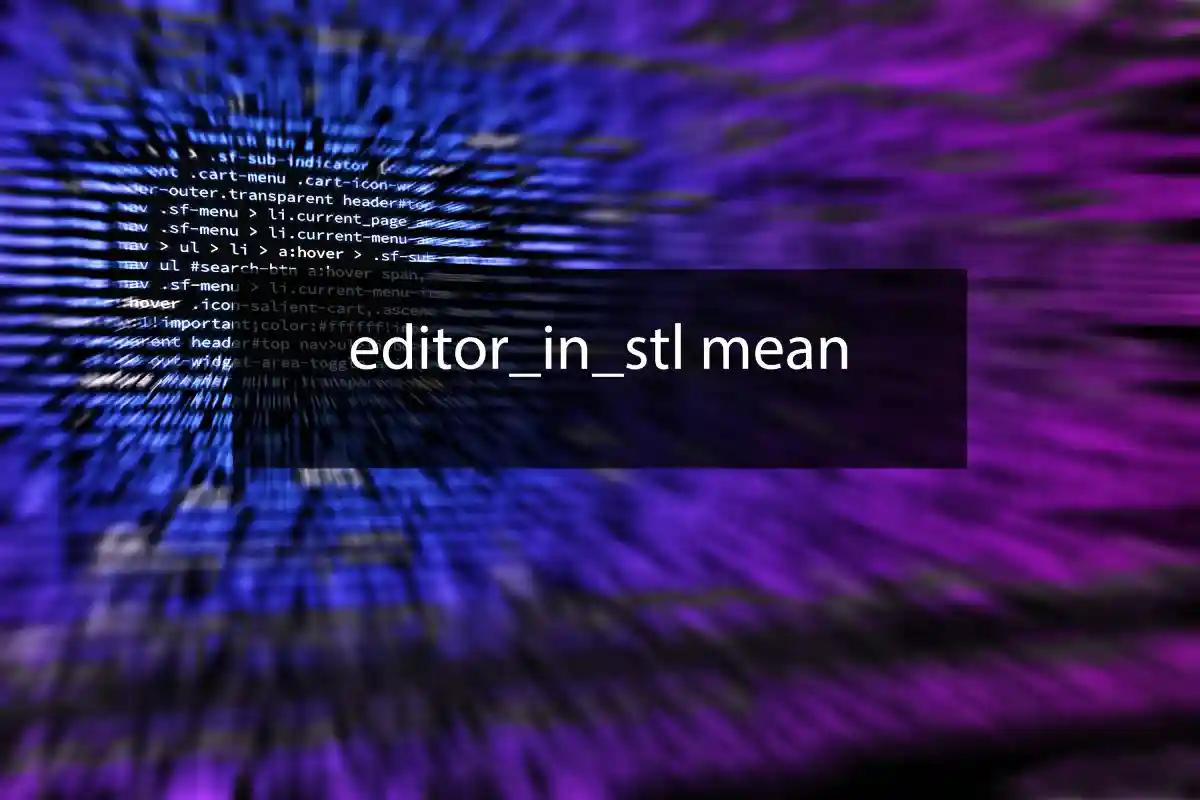When coding in the C++ language and or when you stumble upon the Standard Template Library (STL), you’ll be faced with a host of simple commands and functions that ease your programming. You may have come across some terms in your practice, such as “editor_in_stl mean”. This phrase might sound puzzling and not exactly recognisable when looking at practical STL programming or C++ development; however, it’s quite significant.
In this blog post, I’ll explain what the expression editor_in_stl means and demonstrate its benefits for making code more efficient, with a focus on STL. Here, we’ll Explain what it is and introduce its significance. Demonstrate how you could best utilize it when approaching programming tasks.
Table of Contents
What is STL (Standard Template Library)?
To grasp the situation contained in the terminated string editor_in_stl, we should first learn about what this term is and in what sphere it is used. The Standard Template Library (STL) is a container class template library in C++ that provides quite several generic data structures and functions. The primary intention of STL is to provide optimized, reusable components that free developers time, allowing them to implement familiar algorithms such as sorting, searching and manipulating data collections.
The STL is an invaluable resource to any C++ developer since it has great templates encompassing stuff such as vectors, lists, queues, and stacks, among others. When using STL, a programmer can cut down on the amount of time one would spend trying to develop commonly used algorithms or structures from scratch.

What Does ‘editor_in_stl mean’?
Now, let’s focus on the key term: editor_in_stl mean. First, editor_in_stl mean is defined as a special feature of some programming environment that concerns editors and their work with the STL templates or STL data structures. It is not a commonly used or discussed in basic C++ reference books. Still, this term is indeed significant for those programmers who find themselves using and programming within particular IDEsIDEs or speciality projects or, more specifically, working with the STL (Standard Template Library).
In other words, it expresses the activities and gestures done at the code editor to manage STL templates. Perhaps it was one of the facilities that allowed the developers to implement or modify the STL containers and, thus, enhance performance. The “editor” part may also refer to, among other things, an auto-complete tool that checks for errors and templates together with the STL code.
For instance, if you are coding in Visual Studio or using CLion, editor_in_stl means can be explained in terms of these editors’ kinds of support for STL templates. Such assistance may involve template completion or syntax highlighting to more sophisticated debugging tools or code generators to make the development much easier.
Why is ‘editor_in_stl’ m’an’ important for programmers?
It is very significant for C++ programmers, especially for those who work with STL libraries, to understand what editor_in_stl means and why:
Increases Coding Efficiency: The STL has also included data structure templates alreadythe programmer already writesrammer. However, writing data using these templates may be somewhat nonintuitive and require a lot of time and effort. The concepts found in the editor_in_stl mean, including auto-completion or real-time error highlight, can be helpful to the programmers, saving them time and reducing the possibility of mistakes.
Simplifies Template Management: STL templates are often difficult to handle, particularly when dealing with other data types or structures. Several features support editor_in_stl for the right editor to make using these templates easier. For example, it can either change types or suggest the correct ones depending on the greatest extent allowed.
How to U’e ‘editor_in_stl man’ in Your Projects
This is especially so for C++ developers who work extensively with STL; learning how editor_in_stl works can go a long way to increasing efficiency’s how you can start integrating its features into your projects:
1. Select Best Integrated Development Environment or Code Editor
Probably, the majority of modern IDEs utilize compile-time templates to support STL and implement such handy tools as convenient templates and list and map manipulations with auto-completion. The IDEs that support editor_in_stl mean functionality are Visual Studio, JetBrains CLion and Eclipse IDEs. That includes matters related to STL-specific syntax and auto-completion, not error-checking from these editors. It is important to guarantee that the editor of your choice is well-endorsed to support C++ and STL to improve Coding.
2. Auto-Completion Options Therefore
Another interesting feature of editor_in_stl mean is its suggestions when using STL templates. As soon as you are writing a certain function or pattern, your editor will probably tell you the correct syntax of that function or what functions you can use further. This is particularly useful when working with complex STL containers like std: It accepts a type that could be an instance of < | > or < | > or < | >.
3. Use Template Specialization
Templated specialization in C++ can sometimes be quite complex; however,. Howeverusing editor tools that support the editor_in_stl meansmeans makes the task easier. You might ask your editor for advice or use templates the editor offers to map your data types, making the implementation of template specialization less troublesome.
4. Understand the Error Messages
You may face errors when using the STL code; the editor_in_stl mean functionality enables you to understand these errors easily. Many of today’s editors underline mistakes as they occur and give advice on what to do about them. Consider such messages and try to use them to better debug the required STL-related code.
Improves Debugging: Debugging C++ is often difficult, especially when dealing with the Standard Template Library data type. Editors that native support for editor_in_stl means can assist in efficient debugging by providing debugging aids such as step-through debugging or debugging in graphics, and so on.
Streamlines Code Completion: When writing code using STL templates, one should know the types and functions of STL. However, you do not need to memorize any detail that you read out there on the papers. Editors that support editor_in_stl mean it can be helpful when approaching the STL code since they can remind the appropriate functions or even tcontainer’sr’s methods together with tfunction’sn’s name in case it is forgotten.
Conclusion
Although editor_in_stl sounds very technical, it is a much-needed approach for C++ developers to work with the Standard Template Library. This pertains to the features within the code editors that expand on how we interact with STL templates so that it becomes much easier to manage and debug and, if necessary, optimize code.
In short, knowing what editor_in_stl means could thus make programmers’ coding work much more efficient by minimizing errors and enhancing productivity, whether a new or seasoned developer. The right tools and knowing what role an editor_in_stl has in your editor mean a smoothened and streamlined experience in your programming work.






